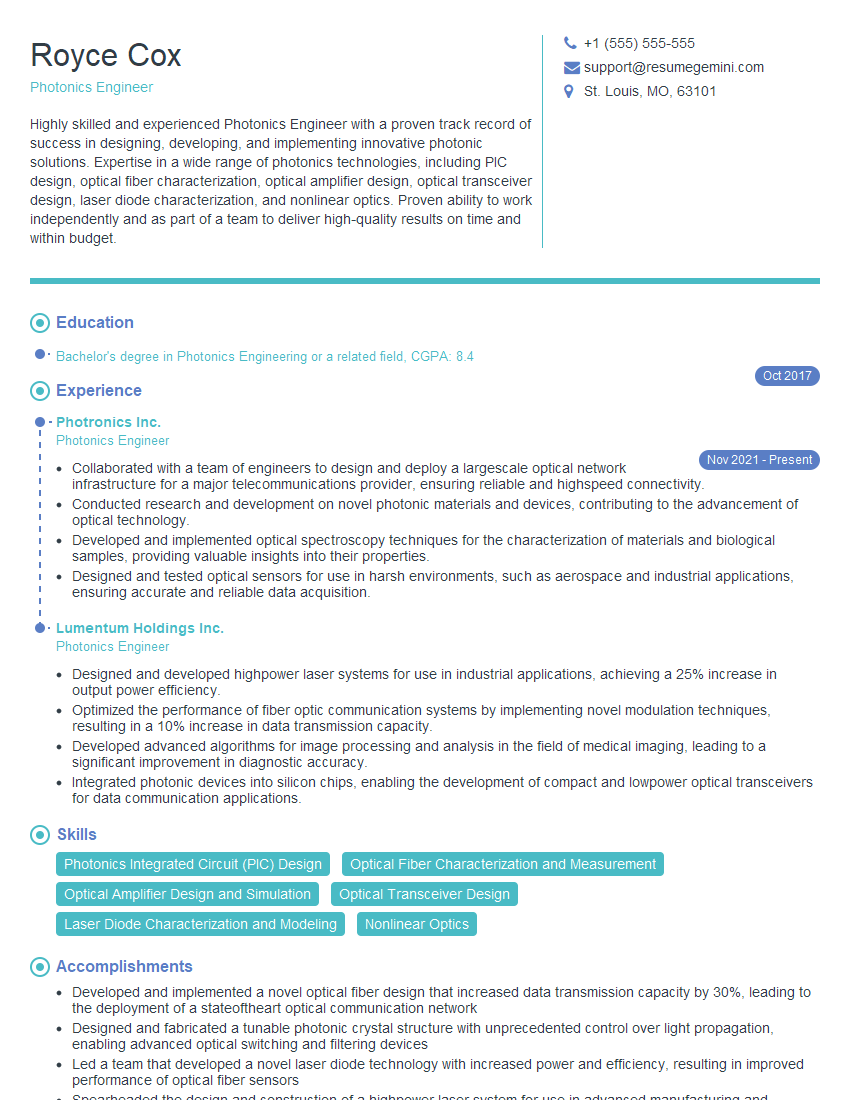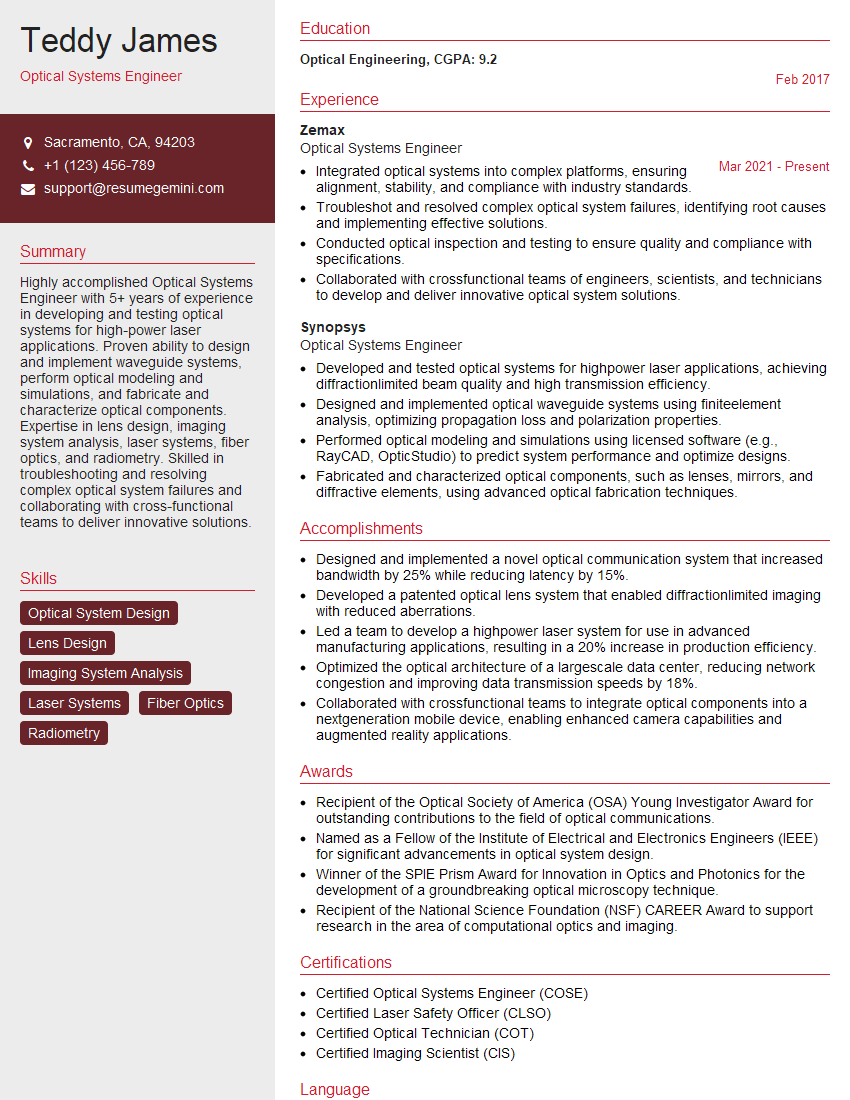Feeling uncertain about what to expect in your upcoming interview? We’ve got you covered! This blog highlights the most important Knowledge of Optical Materials interview questions and provides actionable advice to help you stand out as the ideal candidate. Let’s pave the way for your success.
Questions Asked in Knowledge of Optical Materials Interview
Q 1. Explain the concept of refractive index and its significance in optical materials.
The refractive index (n) of an optical material is a dimensionless number that describes how fast light travels through that material compared to its speed in a vacuum. It’s defined as the ratio of the speed of light in a vacuum (c) to the speed of light in the material (v): n = c/v. A higher refractive index indicates that light travels slower in the material, and consequently, bends more when entering or leaving the material.
This property is crucial in designing optical components. For example, lenses rely on the refractive index difference between the lens material (like glass) and air to bend light and focus it. Different materials have different refractive indices, allowing us to select materials that precisely control the path of light. Without an understanding of refractive index, designing accurate optical systems like cameras, microscopes, or fiber optic cables would be impossible. The variation of refractive index with wavelength (dispersion) also needs careful consideration, as it affects the quality of images formed.
Q 2. Describe different types of optical fibers and their applications.
Optical fibers are thin, flexible strands of glass or plastic that transmit light signals over long distances with minimal loss. They are categorized primarily by their refractive index profile and application.
- Single-mode fibers: These fibers have a small core diameter, allowing only one mode (path) of light to propagate. This results in low signal dispersion and is ideal for long-distance, high-bandwidth communication such as in undersea cables or long-haul telecommunication networks.
- Multi-mode fibers: These fibers have a larger core diameter, allowing multiple modes of light to travel simultaneously. This leads to higher signal dispersion, limiting their use to shorter distances and lower bandwidth applications like local area networks or short-distance data transmission.
- Plastic optical fibers (POF): Made from polymers, POFs are less expensive and easier to handle than glass fibers. However, they have higher attenuation (signal loss) and are primarily used in short-distance applications, like consumer electronics and automotive lighting.
The choice of fiber type depends heavily on the specific application. For example, single-mode fibers are crucial for high-speed internet across continents, while multi-mode fibers suffice for shorter-distance connections within a building. Plastic fibers provide a low-cost alternative for simple, short-range applications.
Q 3. What are the key properties of optical glasses, and how are they characterized?
Optical glasses are inorganic, amorphous materials with unique optical and physical properties. Key properties include:
- Refractive index (n): Determines how much light bends when passing through the glass.
- Dispersion (dn/dλ): Measures the variation of refractive index with wavelength; high dispersion can lead to chromatic aberration in optical systems.
- Abbe number (ν): A measure of dispersion; a higher Abbe number signifies lower dispersion.
- Transmission range: The wavelength range over which the glass transmits light efficiently.
- Thermal expansion coefficient: How much the glass expands or contracts with temperature changes.
- Chemical durability: Resistance to chemical attack.
Optical glasses are characterized using these properties. Manufacturers provide detailed specifications, including refractive index, Abbe number, and transmission curves for different glass types. These specifications are critical for designing optical systems, ensuring the right glass is selected for the application to achieve desired performance. For example, a high-precision camera lens might use low-dispersion glass with a high Abbe number to minimize chromatic aberration and improve image quality.
Q 4. Discuss the principles of optical thin film coatings and their applications.
Optical thin film coatings are extremely thin layers of materials deposited onto optical surfaces to modify the light reflection and transmission characteristics. These coatings work based on the principle of interference. Constructive interference enhances transmission or reflection at desired wavelengths, while destructive interference reduces it.
Applications are vast:
- Anti-reflection coatings: Reduce unwanted reflections, improving light transmission through lenses and other optical components. These are commonly seen on camera lenses and eyeglasses.
- High-reflection coatings: Maximize reflectivity at specific wavelengths, used in mirrors, lasers, and optical filters.
- Dichroic filters: Reflect certain wavelengths while transmitting others, used in color separation in projectors and scientific instruments.
The design of these coatings involves carefully controlling the thickness and refractive index of each layer to achieve the desired optical properties. This often involves sophisticated computer modeling and iterative design processes. The layers are typically deposited using techniques like sputtering or evaporation.
Q 5. Explain the phenomenon of birefringence and its impact on optical systems.
Birefringence is the optical property of a material having a refractive index that depends on the polarization and propagation direction of light. In other words, light traveling through a birefringent material experiences different refractive indices depending on its polarization (e.g., vertically or horizontally polarized). This leads to a splitting of the light beam into two orthogonal polarization states, each traveling at a different speed.
This phenomenon has significant implications in optical systems:
- Polarizers: Utilize birefringence to selectively transmit light of a particular polarization, blocking the other. These are essential components in many optical systems.
- Waveplates: Introduce a specific phase difference between the two polarization components, modifying the polarization state of light. Used in laser systems and optical sensors.
- Stress-induced birefringence: Can be detrimental in optical components as stresses introduced during manufacturing can alter polarization and affect image quality. This must be carefully controlled during the manufacturing of high-precision optical parts.
Understanding and controlling birefringence is crucial for designing high-performance optical systems. For example, minimizing stress-induced birefringence is essential for achieving high image quality in camera lenses.
Q 6. Compare and contrast different types of optical polymers.
Optical polymers offer a range of advantages, including ease of processing, flexibility, and low cost, compared to traditional glass. Different types exist, each with specific properties:
- Polymethyl methacrylate (PMMA): A common, relatively inexpensive polymer with good transparency and decent optical properties. Widely used in lenses, light guides, and optical fibers (POFs).
- Polycarbonate (PC): Stronger and more impact-resistant than PMMA, but with slightly lower optical clarity. Often used in protective lenses and high-impact applications.
- Zeonex and other specialty polymers: Offer enhanced optical properties, like higher refractive index or lower dispersion, suitable for demanding applications like high-precision lenses or specialized optical fibers. These materials often come with higher costs.
The choice of polymer depends on the required balance between cost, optical performance, mechanical strength, and environmental stability. For instance, PMMA is a good choice for simple applications requiring good transparency, whereas polycarbonate is preferred when impact resistance is crucial. Specialty polymers are utilized when exceptional optical performance is required.
Q 7. How do you measure the transmittance and reflectance of an optical material?
The transmittance and reflectance of an optical material are measured using a spectrophotometer. This instrument shines a beam of light through (for transmittance) or onto (for reflectance) a sample and measures the intensity of the transmitted or reflected light at different wavelengths.
The process generally involves:
- Sample preparation: The sample needs to be carefully prepared to ensure accurate measurements. This might include cleaning and polishing the sample surface.
- Measurement: The sample is placed in the spectrophotometer, and the instrument measures the intensity of the light beam before and after interaction with the sample.
- Data analysis: The spectrophotometer calculates transmittance (T) and reflectance (R) as ratios:
T = Itransmitted / IincidentandR = Ireflected / Iincident, where I represents the light intensity. - Calibration: The spectrophotometer must be calibrated regularly using a known standard to ensure accuracy.
The resulting transmittance and reflectance curves provide crucial information about the optical properties of the material at various wavelengths. This data is vital for designing and optimizing optical systems and selecting materials for specific applications.
Q 8. Describe the different types of optical losses in fibers and components.
Optical losses in fibers and components represent the reduction in optical signal power as it propagates. These losses are crucial in designing efficient optical systems, as they limit the transmission distance and signal quality. Several mechanisms contribute to these losses:
Absorption Losses: These occur when the optical material absorbs light energy, converting it into heat. This is often due to impurities within the material or intrinsic absorption related to the material’s electronic structure. For example, the presence of hydroxyl (OH) ions in silica fibers significantly increases absorption around 1.4 μm.
Scattering Losses: These arise when light is scattered in various directions due to microscopic inhomogeneities within the material (e.g., Rayleigh scattering from density fluctuations). Rayleigh scattering is inversely proportional to the fourth power of the wavelength (λ-4), meaning it’s more significant at shorter wavelengths.
Bending Losses: When a fiber bends too sharply, some light can leak out of the core and into the cladding, representing a loss of signal strength. This is especially pronounced in single-mode fibers with tight bends.
Coupling Losses: These occur when connecting different optical components, such as fibers or lenses. Imperfect alignment or mismatch in refractive indices lead to some light being lost during the transfer.
Minimizing these losses is critical for designing high-performance optical systems, often involving careful material selection, precision manufacturing, and optimized component design.
Q 9. What are the advantages and disadvantages of using different optical materials (e.g., glass, polymers, crystals)?
Different optical materials, each with unique properties, are chosen for specific applications based on their advantages and disadvantages:
Glass: Offers excellent transparency across a broad spectral range, high refractive index, and good chemical durability. However, it can be brittle and susceptible to damage. Silica glass (SiO2) is the dominant material in optical fibers due to its low losses.
Polymers: Relatively inexpensive and easy to process, making them suitable for mass-produced components. They offer flexibility and can be molded into complex shapes. However, their transparency window is generally narrower, and they possess lower refractive indices than glass. Polymethyl methacrylate (PMMA) is a common example.
Crystals: Provide exceptional optical properties like high nonlinearity, birefringence (double refraction), and precise control over polarization. Examples include lithium niobate (LiNbO3) used in electro-optic modulators and Yttrium Aluminum Garnet (YAG) used in lasers. However, they are generally more expensive and challenging to fabricate into complex shapes.
The selection depends heavily on the specific application requirements: low loss for long-haul communication, cost-effectiveness for consumer applications, or high nonlinearity for specific photonic devices.
Q 10. Explain the concept of dispersion in optical materials and its effects.
Dispersion is the phenomenon where the refractive index of a material varies with the wavelength of light. This means different wavelengths travel at different speeds through the material. This leads to pulse broadening in optical communication systems, limiting the data transmission rate. There are two main types:
Chromatic Dispersion: This is caused by the wavelength dependence of the refractive index. It can be further divided into material dispersion (intrinsic to the material) and waveguide dispersion (related to the geometry of the optical waveguide).
Polarization Mode Dispersion (PMD): In birefringent media, different polarization states propagate at different speeds, leading to pulse spreading. This is especially relevant in optical fibers.
The effects of dispersion include pulse broadening, intersymbol interference (ISI), and ultimately, a decrease in the signal-to-noise ratio, limiting the system’s bandwidth and transmission distance. Dispersion compensation techniques, such as using dispersion-compensating fibers, are often employed to mitigate these effects.
Q 11. How does temperature affect the properties of optical materials?
Temperature significantly impacts the properties of optical materials. Changes in temperature alter the refractive index, absorption coefficient, and even the physical dimensions of the material. This can lead to:
Refractive Index Change: The refractive index typically increases with decreasing temperature, affecting the propagation characteristics of light.
Absorption Variation: Temperature variations can alter the absorption characteristics, especially in materials with significant temperature-dependent energy levels.
Thermal Expansion/Contraction: This can lead to changes in the dimensions of optical components, potentially affecting alignment and causing stress-induced birefringence.
Thermo-optic effect: This involves a change in refractive index in response to a change in temperature. This effect is used in some optical devices.
Careful temperature control is often necessary for high-precision optical systems and optical fibers in harsh environments to maintain consistent performance and prevent damage.
Q 12. Describe the process of designing an optical system using specific optical materials.
Designing an optical system involves careful consideration of the desired performance and selecting appropriate optical materials to achieve it. The process typically involves:
Defining Specifications: This includes determining the required wavelength range, power handling capability, image quality, and other performance metrics.
Material Selection: This is guided by the specifications and involves considering factors like transparency, refractive index, dispersion, and cost.
Optical Design Software: Sophisticated software packages (e.g., Zemax, Code V) are used to simulate the system’s performance using ray tracing and other techniques. These programs allow for optimization of lens shapes, material choices, and component arrangements.
Tolerance Analysis: Assessing the impact of manufacturing tolerances and environmental factors on the system’s performance.
Prototyping and Testing: Building prototypes and rigorously testing them to validate the design’s performance and identify any unforeseen issues.
For instance, designing a high-power laser system might involve using materials with high damage thresholds and low absorption at the operating wavelength, while a fiber optic communication system would prioritize materials with low dispersion and minimal attenuation.
Q 13. What are some common methods used to fabricate optical components?
Fabrication techniques for optical components are diverse, depending on the material and the desired component. Common methods include:
Polishing: Used to create smooth, high-quality surfaces on glass and crystalline materials. This is essential for minimizing scattering losses.
Molding: Cost-effective method for mass production of plastic components, allowing for complex shapes.
Chemical Vapor Deposition (CVD): Used to deposit thin films of various materials onto substrates, creating optical coatings for anti-reflection, high-reflection, or other specific functions.
Crystal Growth: Used to grow high-quality crystals with specific properties, which are then cut and polished into optical components.
3D printing: Emerging techniques are allowing for more complex shapes and integration of optical elements. This is also used for rapid prototyping.
The choice of fabrication method depends strongly on the material’s properties, desired precision, and the volume of components needed.
Q 14. Explain the concept of optical nonlinearity and its applications.
Optical nonlinearity describes the phenomenon where the response of a material to an optical field is not linearly proportional to the field’s strength. This means that the material’s refractive index or absorption coefficient changes with the intensity of the light. This nonlinear behavior leads to several interesting effects:
Second-Harmonic Generation (SHG): A nonlinear process where two photons of the same frequency combine to generate a single photon at twice the frequency.
Optical Parametric Amplification (OPA): A nonlinear process where a pump photon splits into two photons of lower frequency, amplifying one of them.
Self-Phase Modulation (SPM): The phase of light changes depending on its own intensity, which can lead to spectral broadening and soliton formation.
Applications of optical nonlinearity include:
Frequency conversion: Used in lasers to generate new wavelengths of light.
Optical switching and logic gates: For building all-optical communication systems and computing elements.
Optical signal processing: Used in areas such as optical fiber communications for data manipulation.
Materials with high nonlinearity, such as lithium niobate and certain organic polymers, are crucial for these applications. However, high intensities are often required to observe these nonlinear effects, making it a challenging area of research.
Q 15. What are the challenges in developing new optical materials for high-power laser applications?
Developing optical materials for high-power lasers presents significant challenges due to the extreme conditions involved. The intense energy density can lead to several issues:
Nonlinear Effects: High intensities can induce nonlinear optical effects like self-focusing, stimulated Brillouin scattering, and Raman scattering, which distort the beam and reduce its efficiency. These effects become more pronounced at higher powers.
Thermal Damage: The absorption of even a small fraction of the laser energy can lead to significant temperature increases within the material, causing thermal lensing, stress fracture, and ultimately, material failure. The material’s thermal conductivity and damage threshold are critical factors here. Think of it like focusing sunlight through a magnifying glass – if the material can’t dissipate the heat, it will damage itself.
Material Degradation: The intense light can alter the material’s structure at a microscopic level, leading to changes in its optical properties over time. This can manifest as reduced transmission, increased scattering, or even a change in refractive index. For example, some crystals can undergo color center formation, leading to increased absorption.
Chemical Changes: In some cases, high-power laser irradiation can initiate chemical reactions within the material, affecting its optical and physical properties. For example, the decomposition of certain glasses under intense laser illumination can produce bubbles and scattering centers.
Addressing these challenges requires materials with exceptional properties like high damage thresholds, low nonlinear refractive indices, high thermal conductivity, and excellent chemical stability. Research often focuses on novel material compositions, advanced fabrication techniques, and surface treatments to mitigate these effects.
Career Expert Tips:
- Ace those interviews! Prepare effectively by reviewing the Top 50 Most Common Interview Questions on ResumeGemini.
- Navigate your job search with confidence! Explore a wide range of Career Tips on ResumeGemini. Learn about common challenges and recommendations to overcome them.
- Craft the perfect resume! Master the Art of Resume Writing with ResumeGemini’s guide. Showcase your unique qualifications and achievements effectively.
- Don’t miss out on holiday savings! Build your dream resume with ResumeGemini’s ATS optimized templates.
Q 16. Describe different techniques used to characterize the surface quality of optical components.
Characterizing the surface quality of optical components is crucial for their performance, especially in demanding applications like high-precision imaging and laser systems. Several techniques are employed:
Profilometry: Techniques like atomic force microscopy (AFM) and optical profilometry provide three-dimensional maps of the surface topography, revealing surface roughness, scratches, and other defects at various scales. AFM offers nanoscale resolution, while optical profilometry provides a broader view.
Scatterometry: This technique measures the light scattered from the surface to assess its roughness and other imperfections. The amount and angular distribution of scattered light are directly related to surface quality. It’s particularly useful for evaluating the impact of polishing and other surface treatments.
Interferometry: Interferometers, such as Fizeau or Twyman-Green interferometers, create interference patterns by comparing the wavefront of a test component with a reference wavefront. This allows for extremely precise measurement of surface irregularities, including figure errors (deviations from ideal shape) and surface waviness. These are widely used to verify the quality of lenses and mirrors.
Scanning Electron Microscopy (SEM): SEM provides high-resolution images of the surface, revealing details of surface structure, scratches, and other defects at the micro- and nanoscale. It’s a valuable tool for detailed inspection of surface morphology.
The choice of technique depends on the desired level of detail, the type of defect being investigated, and the size and shape of the optical component.
Q 17. How would you select the appropriate optical material for a specific application?
Selecting the right optical material for a specific application requires careful consideration of several factors:
Wavelength of Operation: The material’s transmission range must encompass the wavelengths of interest. For example, fused silica is ideal for the UV-Vis-NIR range, while some chalcogenide glasses are preferred for the mid-infrared.
Refractive Index: This determines how much the material bends light and is crucial for lens design and other applications. The refractive index can also be a function of the wavelength (dispersion).
Transmission and Absorption: High transmission is crucial in applications where minimizing light loss is important. Absorption can lead to heating and other detrimental effects, particularly in high-power applications.
Mechanical and Thermal Properties: Factors like strength, hardness, thermal expansion, and thermal conductivity influence the material’s suitability for different environments and applications.
Cost and Availability: This is often a practical limiting factor. Some high-performance materials are significantly more expensive than readily available alternatives.
Chemical Resistance: The material’s resistance to chemical attack is important for applications where it might be exposed to harsh environments or corrosive substances.
For instance, choosing a material for a high-power laser system would require a material with a high damage threshold, low nonlinear refractive index, and high thermal conductivity. In contrast, designing a lens for a visible-light camera might prioritize optical clarity, minimal dispersion, and affordable cost.
Q 18. Explain the role of optical materials in various applications, such as telecommunications, imaging, and sensing.
Optical materials play a vital role in a wide range of applications:
Telecommunications: Optical fibers, made of silica glass doped with specific elements, form the backbone of modern telecommunications networks, enabling high-bandwidth data transmission over long distances. The choice of fiber type depends on the wavelength and data rate.
Imaging: Lenses, prisms, and filters, made from materials like glass, crystals, and polymers, are essential components in cameras, microscopes, telescopes, and other imaging systems. The selection of material depends on factors like the required resolution, wavelength range, and image quality.
Sensing: Optical materials are used in various sensors to detect and measure physical and chemical quantities. For example, optical fibers can be used as sensors for temperature, strain, and pressure, while photodetectors made from materials like silicon or cadmium sulfide are essential for detecting light signals.
In each application, the properties of the optical material are carefully chosen to optimize system performance. For example, the low loss and high bandwidth of silica glass are crucial for its use in optical fibers, while the high refractive index of certain crystals is important for their use in lenses.
Q 19. What are some common defects in optical materials, and how do they affect performance?
Several defects can affect the performance of optical materials:
Inclusions: These are small foreign particles within the material, which can scatter light and reduce transmission. They can originate from impurities in the raw materials or during the manufacturing process.
Striae: These are variations in refractive index within the material, often appearing as streaks or lines. They can distort the wavefront and degrade image quality.
Bubbles: These voids within the material can scatter light and reduce transmission. They are common in some glasses.
Cracks and Scratches: Surface imperfections can scatter light and reduce the efficiency of optical components. These are often caused during handling or processing.
Color Centers: Certain crystals and glasses can develop color centers under irradiation, which absorb light and reduce transmission. This is particularly relevant in high-power laser applications.
The impact of these defects on performance depends on their size, density, and location within the material. Advanced manufacturing techniques and quality control measures are essential to minimize these defects and enhance the performance of optical components.
Q 20. Describe the process of selecting optical adhesives or sealants.
Selecting optical adhesives or sealants is a critical aspect of assembling optical systems. The choice depends on several factors:
Optical Properties: The adhesive must have a refractive index that is matched to the components being bonded to minimize reflection losses at the interface. Transparency across the relevant wavelength range is also essential.
Mechanical Properties: The adhesive must have sufficient strength and elasticity to withstand environmental stresses, such as temperature fluctuations and vibrations.
Chemical Compatibility: The adhesive should not react chemically with the optical components being bonded, or else it might degrade their properties over time.
Curing Process: The curing process should not introduce stress or other defects into the optical components. UV-curable adhesives are often preferred for their fast curing time and low heat generation.
Viscosity: The viscosity of the adhesive should be appropriate for the application; too viscous, and it might be difficult to apply uniformly; too low, and it might sag or flow excessively.
A thorough understanding of these factors is essential for selecting the appropriate optical adhesive or sealant for any given application. For example, UV curable epoxy might be selected for a small, precise assembly, while a thermally curable silicone might be better suited for large components.
Q 21. Explain different types of optical filters and their design considerations.
Optical filters are used to selectively transmit, reflect, or absorb specific wavelengths of light. Several types exist:
Bandpass Filters: These transmit a narrow range of wavelengths while blocking others. They are commonly used in spectroscopy and imaging applications to isolate specific spectral features.
Longpass Filters (High-Pass Filters): These transmit wavelengths longer than a specified cutoff wavelength. These are useful in fluorescence applications.
Shortpass Filters (Low-Pass Filters): These transmit wavelengths shorter than a specified cutoff wavelength. This could be used for imaging experiments to isolate particular bands of wavelengths.
Notch Filters: These block a narrow range of wavelengths while transmitting others. These can be used to remove specific unwanted spectral lines, such as those from mercury discharge lamps.
Neutral Density Filters: These attenuate light intensity across a wide range of wavelengths without changing the spectral distribution. Used to control light levels in many optical systems.
The design considerations for optical filters include the desired spectral characteristics (transmission curve), the required optical density (attenuation), the angle of incidence of the light, and the environmental conditions. Design techniques often involve thin-film interference coatings, utilizing materials with varying refractive indices deposited in thin layers onto substrates. Precise control over the layer thicknesses allows for fine-tuning the filter’s transmission characteristics.
Q 22. How does the choice of substrate material impact the performance of optical components?
The substrate material significantly impacts the performance of optical components. Think of it like the foundation of a house – a weak foundation compromises the entire structure. The substrate provides mechanical support, thermal stability, and often influences the optical properties of the component itself. For instance, a substrate’s surface roughness can scatter light, reducing the efficiency of a lens or mirror. Its thermal expansion coefficient must match that of the active optical material to prevent stress-induced cracking or distortion, especially critical in applications involving temperature variations. The substrate’s transmission properties in the wavelength range of operation are also crucial. For example, a silicon substrate is highly absorbing in the visible spectrum, making it unsuitable for visible-light applications, whereas fused silica is highly transparent across a wide spectral range, making it ideal for many optical components.
- Example 1: In high-power laser applications, a substrate with high thermal conductivity, like copper or diamond, is crucial to dissipate heat efficiently and prevent damage to the active optical material.
- Example 2: In precision optical instruments, a substrate with extremely low thermal expansion, like Zerodur (a glass-ceramic), is vital for maintaining dimensional stability over temperature fluctuations.
Q 23. Describe the concept of Abbe number and its significance in optical design.
The Abbe number, denoted by νd, is a measure of a material’s dispersion – its ability to separate light of different wavelengths. It’s calculated as the ratio of the refractive index at the Fraunhofer d-line (587.6 nm, Helium-yellow) minus 1, to the difference between the refractive indices at the Fraunhofer F-line (486.1 nm, Hydrogen-blue) and C-line (656.3 nm, Hydrogen-red). A higher Abbe number signifies lower dispersion. This is crucial in optical design because materials with different Abbe numbers are combined to correct chromatic aberration – the blurring of an image caused by different wavelengths focusing at slightly different points.
Significance: In lens design, for instance, combining a high-index, low-Abbe number material (like flint glass) with a low-index, high-Abbe number material (like crown glass) allows designers to compensate for chromatic aberration and achieve sharper, more accurate images. Choosing materials with appropriate Abbe numbers is essential to minimize color fringing and improve the overall quality of optical systems.
Q 24. Explain the difference between linear and nonlinear optical materials.
The key difference lies in how they respond to light. Linear optical materials exhibit a linear relationship between the polarization of light and the applied electric field. In simpler terms, the light goes through the material unchanged except for some absorption, scattering, and refractive index change. The material’s response is proportional to the input light intensity. Most optical materials fall under this category.
Nonlinear optical materials, on the other hand, show a nonlinear response. Their refractive index or other optical properties change with the intensity of the incident light. This means that the output light can have different wavelengths (frequency) or polarization compared to the input light. This nonlinearity allows for phenomena such as second-harmonic generation (doubling the frequency of light) and optical parametric oscillation (generating light at different frequencies). Examples include crystals like Lithium Niobate (LiNbO3) and Potassium Titanyl Phosphate (KTP), used in frequency doubling lasers and optical modulators. Think of it like this: a linear material is like a straight road – the light travels without changing direction or speed. A nonlinear material is like a winding road where the light’s path changes based on its intensity.
Q 25. How are optical materials tested for radiation hardness?
Testing optical materials for radiation hardness involves exposing them to various types of ionizing radiation (like gamma rays, X-rays, and electrons) and measuring the changes in their optical properties. The goal is to determine how well the material can withstand radiation exposure without significant degradation in transmission, refractive index, or other crucial parameters. This is particularly vital in space applications, nuclear reactors, and high-energy physics experiments.
The tests typically involve irradiating samples with known doses of radiation and then measuring their optical properties before and after irradiation. These measurements might include transmission spectra, refractive index changes, and the introduction of color centers (defects absorbing light at specific wavelengths). The results are then used to determine the material’s radiation tolerance and predict its performance under various radiation environments. Different parameters are tracked such as total ionizing dose (TID) effects and displacement damage.
Q 26. What are some emerging trends in the field of optical materials?
Several emerging trends are shaping the field of optical materials. Metamaterials, artificially engineered materials with properties not found in nature, are enabling novel optical devices with functionalities like perfect lenses and cloaking devices. Photonic crystals, with periodic variations in their refractive index, offer precise control over light propagation, finding applications in optical filters and waveguides. The development of new nonlinear optical materials with improved efficiency and broader wavelength coverage is driving advancements in laser technology and optical communication. 2D materials, like graphene and transition metal dichalcogenides (TMDs), are being explored for their unique optical properties and potential for use in ultra-thin optical devices.
Additionally, there’s a growing emphasis on developing sustainable and environmentally friendly optical materials, reducing the impact of their production and disposal on the planet. Research in bio-inspired optical materials, mimicking the optical structures found in nature, is also gaining momentum.
Q 27. Discuss the environmental impact of manufacturing and disposal of optical materials.
The manufacturing and disposal of optical materials have significant environmental implications. The production process often involves energy-intensive procedures and the use of hazardous chemicals. For example, the smelting of glass involves high temperatures and releases greenhouse gases. The extraction and processing of rare earth elements, often used in certain optical materials, can be environmentally damaging, with potential for water and soil contamination. The disposal of some optical materials, particularly those containing heavy metals, can also lead to environmental pollution if not handled properly.
Mitigation strategies include exploring the use of less harmful chemicals, improving energy efficiency in manufacturing processes, developing recyclable optical materials, and designing safer disposal methods. Life cycle assessments (LCAs) are crucial for evaluating the overall environmental impact of optical materials, from raw material extraction to end-of-life management.
Q 28. Describe the challenges in integrating different optical materials in a complex system.
Integrating different optical materials in a complex system presents several challenges. One key issue is the mismatch in material properties. Differences in refractive indices can lead to reflections and losses at interfaces, reducing the system’s overall efficiency. Variations in thermal expansion coefficients can cause stress and cracking at interfaces due to temperature changes. The chemical compatibility of different materials is also critical; some materials may react with each other, degrading performance or causing the system to malfunction.
Addressing these challenges often involves employing techniques like anti-reflection coatings to minimize reflections at interfaces, careful material selection to match thermal expansion coefficients, using adhesives or bonding techniques that ensure strong and stable interfaces, and optimizing the system’s design to minimize stress concentrations. Advanced techniques like graded index materials or carefully designed transition layers can also help smooth out property variations across interfaces, reducing losses and improving system performance.
Key Topics to Learn for Knowledge of Optical Materials Interview
- Refractive Index and Dispersion: Understanding how different materials bend light, its dependence on wavelength, and implications for lens design and optical systems.
- Absorption and Transmission: Analyzing how materials interact with light, considering factors like bandgap, impurities, and applications in filters and optical fibers.
- Scattering and Diffraction: Exploring how light interacts with imperfections in materials, its impact on image quality, and relevance in areas like anti-reflection coatings.
- Optical Properties of Common Materials: Gaining familiarity with the characteristics of glasses, crystals, polymers, and semiconductors used in optical applications, including their advantages and limitations.
- Nonlinear Optical Effects: Understanding phenomena like second-harmonic generation and their role in advanced technologies such as lasers and optical data storage.
- Material Characterization Techniques: Familiarizing yourself with methods like spectroscopy, ellipsometry, and microscopy used to measure and analyze optical material properties.
- Practical Applications: Exploring the use of optical materials in various fields, such as telecommunications, imaging, sensing, and display technologies.
- Problem-Solving Approaches: Developing the ability to analyze optical system performance, identify limitations, and propose solutions based on material selection and design.
Next Steps
Mastering knowledge of optical materials is crucial for career advancement in fields demanding cutting-edge technological expertise. A strong understanding of these concepts opens doors to exciting opportunities in research, development, and engineering. To maximize your job prospects, crafting an ATS-friendly resume is essential. This ensures your qualifications are effectively communicated to hiring managers and Applicant Tracking Systems. We strongly recommend using ResumeGemini to build a professional and impactful resume that highlights your skills and experience. ResumeGemini provides examples of resumes tailored to Knowledge of Optical Materials to help you showcase your expertise effectively.
Explore more articles
Users Rating of Our Blogs
Share Your Experience
We value your feedback! Please rate our content and share your thoughts (optional).
What Readers Say About Our Blog
Interesting Article, I liked the depth of knowledge you’ve shared.
Helpful, thanks for sharing.
Hi, I represent a social media marketing agency and liked your blog
Hi, I represent an SEO company that specialises in getting you AI citations and higher rankings on Google. I’d like to offer you a 100% free SEO audit for your website. Would you be interested?








